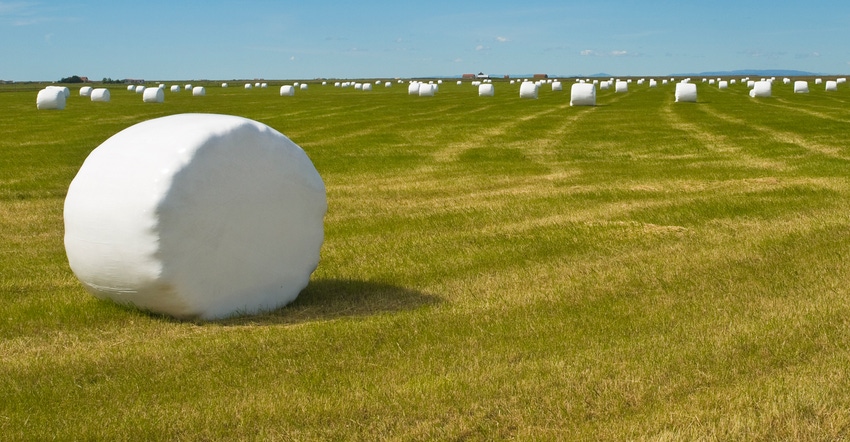March 24, 2020

It’s hard to believe but hay harvesting will start soon in the Northeast. If you’re going to be storing hay as baleage, there are additional costs and potential benefits compared to harvesting dry hay.
To capture all the potential benefits of baleage, farmers need to make sure they have the proper management in place to succeed.
With plastic wrapped baleage the advantages are clear: A reduction in drying time, better leaf retention compared to dry hay, no storage structures needed and a reduction in weather risk. But there are added expenses, too, and like most other things in agriculture it can be a game of figuring out what will pay in your farm situation.
1. It costs more. The last Pennsylvania Custom Rate Report put bale wrapping in a range between $7 to $8 a bale. And there is a cost to dispose the plastic, including your time, and hauling and landfill fees.
But with very large numbers of white bales dotting the landscape, many folks clearly see wrapping hay bales as a beneficial practice for their farm.
2. Shoot for 45% to 55% moisture. Most farmers seem to have their preference on moisture levels, and many farmers I talked to prefer baleage that is a little on the drier side.
In general, research on the topic has shown that moisture should be in the range of 45% to 55%. This range creates the most favorable conditions for fermentation.
Studies by USDA-ARS have shown almost no lactic acid production occurring in baleage below 42% moisture. Bales at lower moisture may have little to no fermentation but wrapping protects them from spoiling.
On the other hand, moisture levels that are too high can cause clostridial fermentation with resulting high levels of butyric acid and ammonia. This is the baleage that has a wet, slimy appearance and an awful smell. Baleage in this situation can be risky to feed.
3. Wrap it tight. Another question is how much plastic should be used.
To make quality baleage, air must be eliminated as much as possible from inside the bale. This means making a tight bale. Furthermore, it means putting enough plastic on the bale to stop any movement of air into it.
Researchers at University of Wisconsin have looked at using 1- and 1.5-milliliter plastic along with various numbers of wrappings. Internal bale temperatures were monitored and showed that bales wrapped with at least 6 mL of plastic (either four 1.5-mL layers or six 1-mL layers) had an immediate temperature drop and reached ambient temperature in about eight to nine days.
The researchers concluded that bales should receive at least 6 ml of total plastic. The total plastic thickness, not number of wraps, appears to be the most important factor.
4. Do it in 24 hours or less. Another question that comes up is how long can bales sit without being wrapped before quality is compromised?
During the rush of haymaking, the reality is that sometimes bales need to wait longer for wrapping than you would like. But how long is too long?
Another University of Wisconsin study looked at wrapping bales at zero, 12, 24, 36, 48, 72 and 96 hours after baling. The researchers concluded that bales should be wrapped within 24 hours after baling to avoid quality problems caused by high internal bale temperatures associated with long delays in wrapping.
Other studies have concluded that the critical point is perhaps closer to 12 hours. Factors such as moisture level at baling and the forage species being wrapped could play a role.
Obviously, your goal needs to be getting bales wrapped as soon as possible after baling, within 12 hours if possible. The second 12 hours up to 24 gets a little dicey, and if it gets beyond 24 hours, you can expect quality issues.
5. Be careful with sheep. Penn State Extension sometimes get questions about whether sheep should be fed baleage.
It is commonly known that sheep are more susceptible to Listeria monocytogenes and can contract listeriosis, or “circling disease,” more readily than cattle. Also, abortions are common in sheep and goats that are exposed to Listeria monocytogenes.
For these reasons, some stock owners will avoid using baleage for sheep. Some feed it regularly and have no problems, others will avoid bales that show any signs of mold. Experts recommend managing the baleage process to avoid getting soil in bales since Listeria is a soil-borne bacterium.
Good fermentation is important to help prevent Listeria from proliferating.
The popularity of plastic wrapped bales seems to be here to stay. Like many other practices, close management and paying attention to details is required for success.
Hartman is a Penn State livestock Extension educator
Source: Penn State Cooperative Extension, which is solely responsible for the information provided and is wholly owned by the source. Informa Business Media and all its subsidiaries are not responsible for any of the content contained in this information asset.
Read more about:
BaleageYou May Also Like




